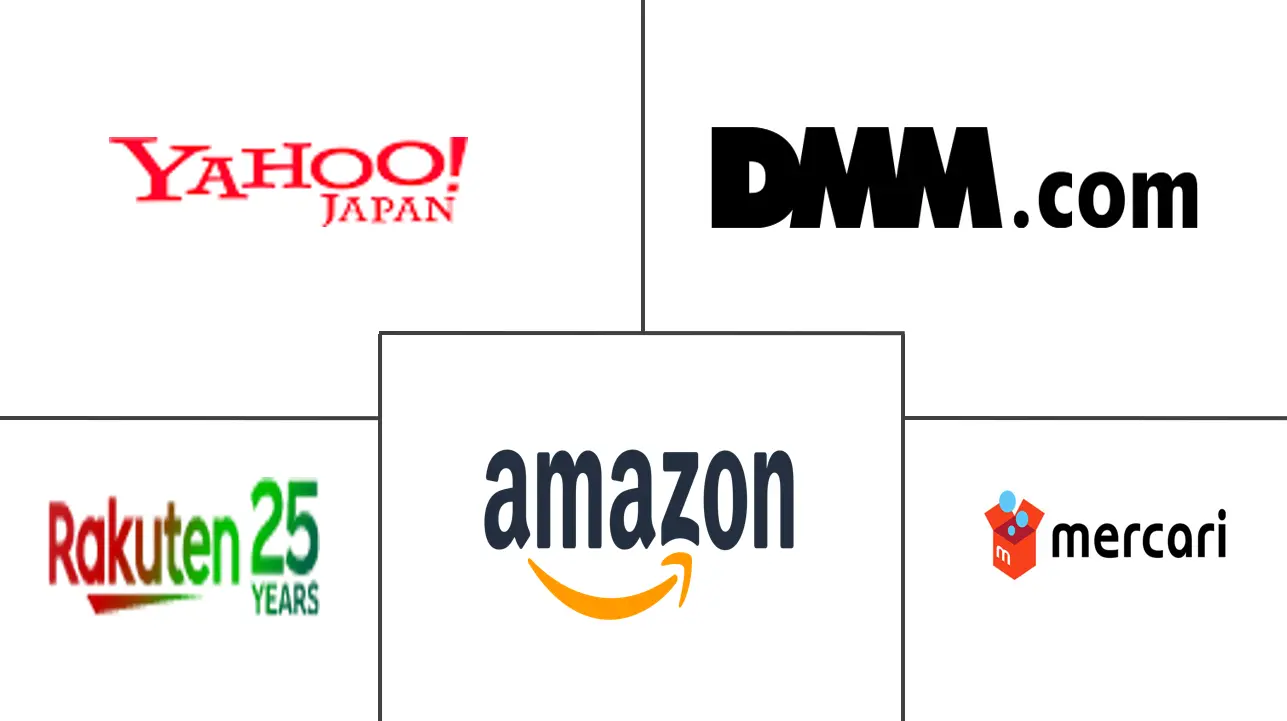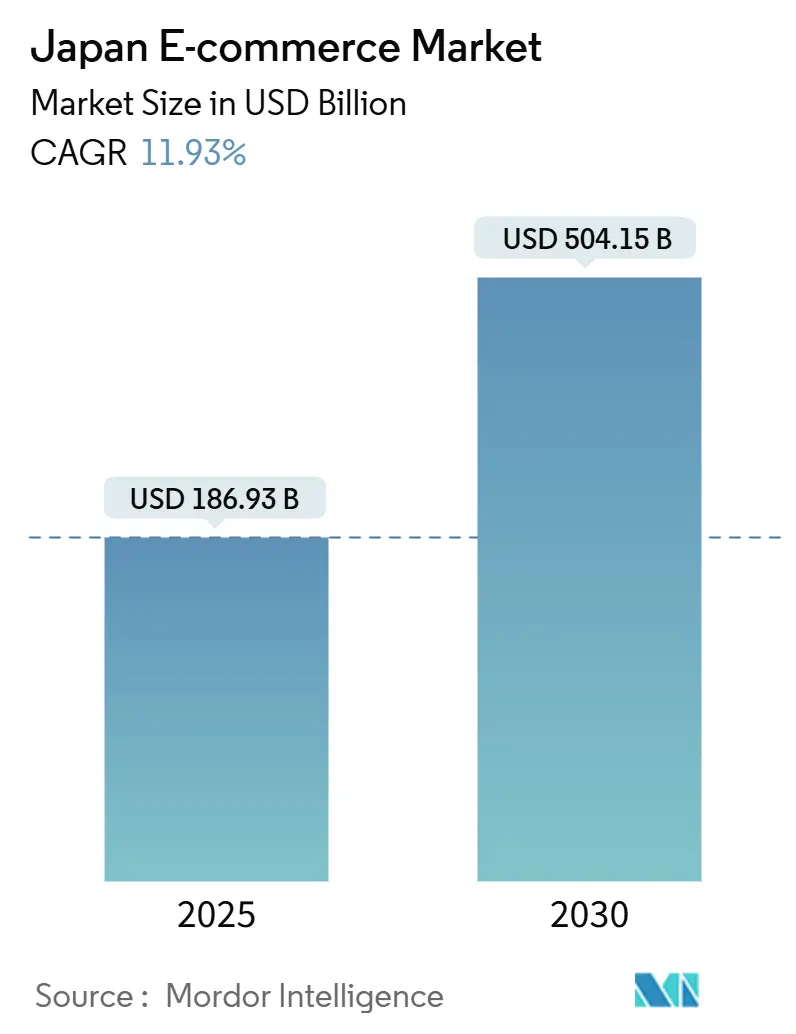
Japan E-commerce Market Analysis by Mordor Intelligence
The Japan e-commerce market size stands at USD 186.93 billion in 2025 and is forecast to register an 11.93% CAGR to USD 504.15 billion by 2030. Rising mobile penetration, government incentives for cashless payments, and the strong pull of cross-border platforms are setting the tone for the next five years of expansion in the Japan e-commerce market.1Ministry of Economy, Trade and Industry, “令和5年度 電子商取引に関する市場調査,” Ministry of Economy, Trade and Industry, meti.go.jp Retailers are focusing on app-first experiences, logistics automation, and ecosystem partnerships to control rising fulfillment costs, especially after the “2024 Problem” capped driver overtime. The silver-economy cohort is increasing online spending, and the B2B channel continues to anchor overall transaction value, aided by tax breaks for e-procurement upgrades. Meanwhile, Chinese entrants are deploying price-led acquisition tactics that intensify competitive pressure but also prompt domestic leaders to accelerate service innovation and loyalty programs.2Japan Fair Trade Commission, “Outline of the Act on Promotion of Competition for Specified Smartphone Software,” Japan Fair Trade Commission, jftc.go.jp
Key Report Takeaways
- By business model, B2B commanded 88% of the Japan e-commerce market share in 2024; C2C is projected to expand at a 16.5% CAGR between 2025-2030.
- By device type, smartphones captured 65% of the Japan e-commerce market size in 2024 and are growing at a 14.2% CAGR through 2030.
- By payment method, credit/debit cards held 68% share of the Japan e-commerce market size in 2024, while digital wallets are advancing at an 18.1% CAGR to 2030.
- By B2C product category, food & beverages led with 20% revenue share in 2024; beauty & personal care is forecast to expand at a 12.8% CAGR through 2030.
Japan E-commerce Market Trends and Insights
Drivers Impact Analysis
| Driver | (~) % Impact on CAGR Forecast | Geographic Relevance | Impact Timeline |
|---|---|---|---|
| Rising Silver-Economy Digital Spend in Urban Prefectures | +2.5% | National, with concentration in Tokyo, Osaka, and Nagoya | Medium term (2-4 years) |
| Consolidation of 1-Hour Hyper-Local Delivery Networks in Tokyo & Osaka | +1.8% | Tokyo and Osaka metropolitan areas | Short term (≤ 2 years) |
| Government Cashless-Subsidy Extension to 2027 | +1.3% | National | Medium term (2-4 years) |
| Corporate Tax Incentives for B2B E-procurement Platforms | +1.2% | National | Medium term (2-4 years) |
| Surge in In-game & Livestream-Commerce Monetisation | +0.9% | National, with higher impact in urban areas | Short term (≤ 2 years) |
| Rapid Uptake of BNPL among Gen-Z Females | +0.8% | National, with concentration in major cities | Short term (≤ 2 years) |
| Source: Mordor Intelligence | |||
Rising Silver-Economy Digital Spend in Urban Prefectures
Senior households allocate JPY 230,000 (USD 1,533) monthly and a growing slice flows through online channels, propelling the Japan e-commerce market. Urban digital-literacy campaigns and larger smartphone screens have lowered usability barriers, while merchants design senior-friendly navigation and bigger font sizes to lift conversion. Healthcare devices, premium travel packages, and safe-investment products now headline many storefronts targeted at affluent retirees. Households led by individuals aged 60-64 also influence broader family purchases, deepening the ripple effect on total transaction volumes. This demographic surge is expected to underpin steady mid-term demand, cushioning the sector from youth-population decline.3Japan External Trade Organization, “拡大するEC市場(世界),” Japan External Trade Organization, jetro.go.jp
Consolidation of 1-Hour Hyper-Local Delivery Networks in Tokyo & Osaka
Micro-fulfillment nodes around dense population clusters are shrinking average delivery windows to 60 minutes, raising consumer service expectations across categories. Retailers deploy AI inventory placement to cut stock-outs and rely on electric vans and cargo bikes to lower emissions. The Tokyo “Smart City” program subsidises digital route-mapping, encouraging nimble entrants to challenge incumbents on last-mile speed. Perishable food, impulse electronics accessories, and pharmaceutical refills benefit most from this logistics leap. Early adopters report double-digit uplift in repeat-purchase frequency, directly supporting the Japan e-commerce market’s growth targets.
Government Cashless-Subsidy Extension to 2027
Cashback reimbursements and merchant-terminal rebates have driven cashless ratios toward the 50% policy target, smoothing checkout flows and reducing handling errors. SMEs once reluctant to shoulder interchange fees now accept QR wallets, broadening the addressable audience. Rural convenience-store owners install multi-payment kiosks that feed online sales channels through click-and-collect models. The initiative interacts positively with digital ID and tax-refund automation, making online shopping easier for inbound tourists. Together these effects reinforce the Japan e-commerce market’s trajectory toward higher transaction velocity.
Corporate Tax Incentives for B2B E-procurement Platforms
Accelerated depreciation on digital upgrades has unlocked capital budgets across factory networks and wholesalers. Enterprises migrating to cloud-based marketplaces cut average procurement cycles by 30 days and redirect working capital into R&D. Platform vendors integrate predictive analytics for spare-parts ordering, lowering downtime in electronics and automotive plants. The resulting efficiency tailwind supports competitive exports and drives incremental order volumes within the Japan e-commerce market. SMEs in regional industrial clusters replicate these advantages through subscription models, narrowing the digital divide.
Restraints Impact Analysis
| Restraint | (~) % Impact on CAGR Forecast | Geographic Relevance | Impact Timeline |
|---|---|---|---|
| Logistics Labour Shortage Beyond 2026 (Yamato "2024 Problem") | -0.7% | National, with severe impact in rural areas | Long term (≥ 4 years) |
| Persistent Preference for COD in Rural Shoppers | -0.6% | Rural prefectures | Medium term (2-4 years) |
| Digital-Platform Fair-Trading Act Compliance Costs | -0.5% | National | Short term (≤ 2 years) |
| Ageing IT Infrastructure of SME Sellers | -0.4% | National, with concentration in smaller cities | Medium term (2-4 years) |
| Source: Mordor Intelligence | |||
Logistics Labour Shortage Beyond 2026 (“2024 Problem”)
The driver overtime cap to 960 hours annually has already created a 14.2% transport-capacity gap and projections signal a 34.1% shortfall by 2030. Retailers face surcharges that erode margins and lengthen delivery commitments outside metro zones, dampening customer experience benchmarks in the Japan e-commerce market. Major carriers charter cargo flights and trial sidewalk robots, but scale deployment lags demand. Autonomous-vehicle legislation remains under consultation, constraining immediate relief. The structural nature of Japan’s shrinking working-age population implies that logistics automation, not workforce recovery, will define sustainable fulfillment economics.4Sumitomo Mitsui Trust Asset Management, “The Current State of the 2024 Logistics Crisis,” SuMi TRUST, sumitrust-am.com
Persistent Preference for COD in Rural Shoppers
Cash-on-delivery still anchors trust where broadband quality, smartphone penetration, and familiarity with digital wallets lag. COD handling fees, reversal risk, and longer payment cycles inflate seller cost structures. Government agency awareness campaigns are narrowing the gap, yet meaningful adoption hinges on improved rural connectivity and continued exposure to secure payment experiences. Until then, the Japan e-commerce market must carry the inefficiency drag of mixed payment systems across its geography.
Segment Analysis
By Business Model: B2B Dominance Masks C2C Innovation
The B2B channel represented 88% of the Japan e-commerce market share in 2024, buoyed by JPY 465.24 trillion (USD 3.1 trillion) in transaction value and a 40% online penetration rate. Automotive, electronics, and industrial suppliers accelerate adoption to streamline procurement amid a tightening labour pool. Tax incentives for digital platforms compress ROI timelines, while end-to-end visibility on component orders improves production scheduling. Digital catalogues support rapid product configuration, reinforcing B2B’s central role in the Japan e-commerce market.
C2C, though smaller, posts a 16.5% CAGR through 2030 as Mercari and peer-rivals simplify listing and escrow services. Environmental awareness and budget-savvy youth fuel demand for preloved fashion and electronics, creating circular-economy traction. Platform AI authenticates high-value items, boosting trust. Meanwhile, the B2C segment adds JPY 24.84 trillion (USD 165.6 billion) in 2024 sales, underscoring that each model plays a distinct growth role inside the Japan e-commerce market.
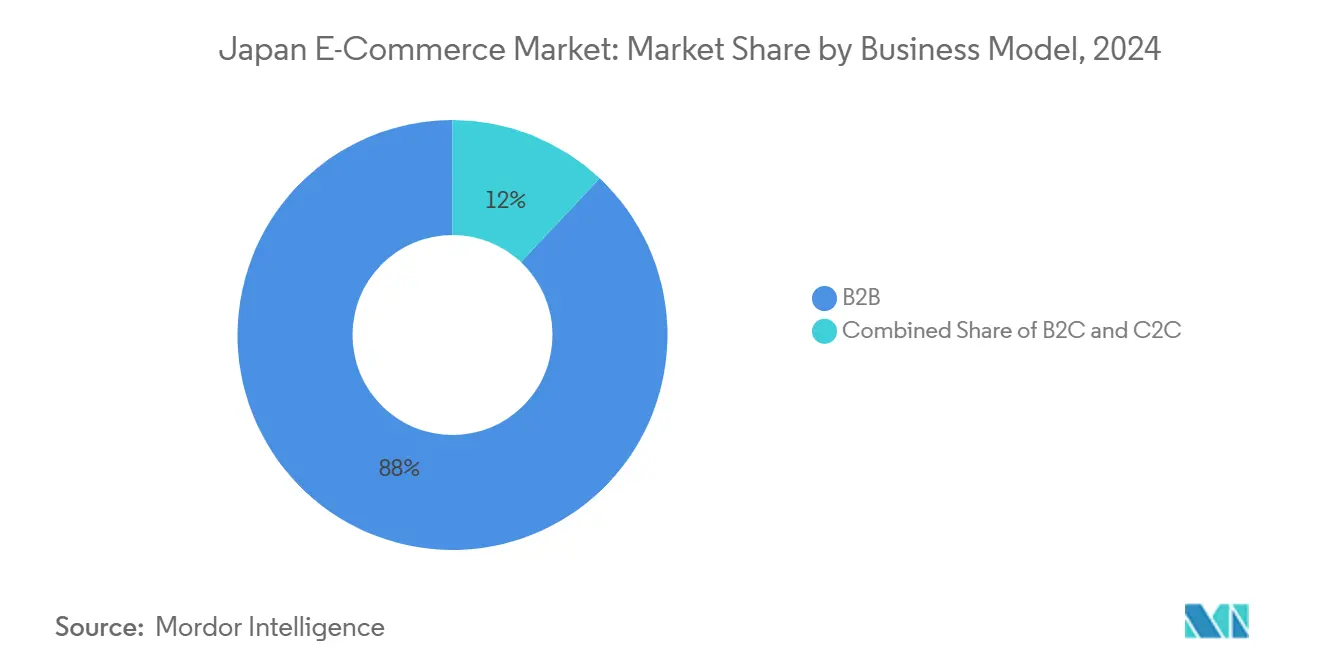
Note: Segment shares of all individual segments available upon report purchase
By Device Type: Mobile-First Strategy Reshapes User Experience
Smartphones generated 65% of all 2024 online transactions and headline a 14.2% CAGR outlook as biometric login and 5 G networks raise session frequency. Retailers design vertical-scroll “super-apps” that combine shopping, livestream, and loyalty wallets to capture dwell time. Push-notification precision and camera-based AR elevate impulse conversion, insulating mobile from desktop cannibalisation.
Desktop and laptop channels stay relevant for high-ticket B2B purchases where dual-screen comparison and PDF downloads remain essential. Voice-enabled commerce via smart speakers attracts seniors who prefer conversational interfaces, while smart-TV checkout caters to family group viewing. These device-tailored approaches diversify access points to the Japan e-commerce market and diffuse risk of platform-specific disruptions.
By Payment Method: Digital Wallets Challenge Card Dominance
Credit and debit cards secured 68% of the Japan e-commerce market size in 2024, supported by fraud-protection programs and instalment add-ons. Yet wallet services such as PayPay, LINE Pay, and Rakuten Pay record 18.1% CAGR to 2030, due to QR interoperability and points ecosystems. Loyalty-point redemption at checkout effectively discounts goods and expands user bases beyond early adopters.
BNPL products win traction among Gen-Z buyers, driving affinity in fashion and beauty carts. Issuers integrate real-time underwriting to manage delinquency risk. Bank transfers and convenience-store codes continue serving rural cohorts, illustrating that payment diversity remains a strategic necessity in the Japan e-commerce market.
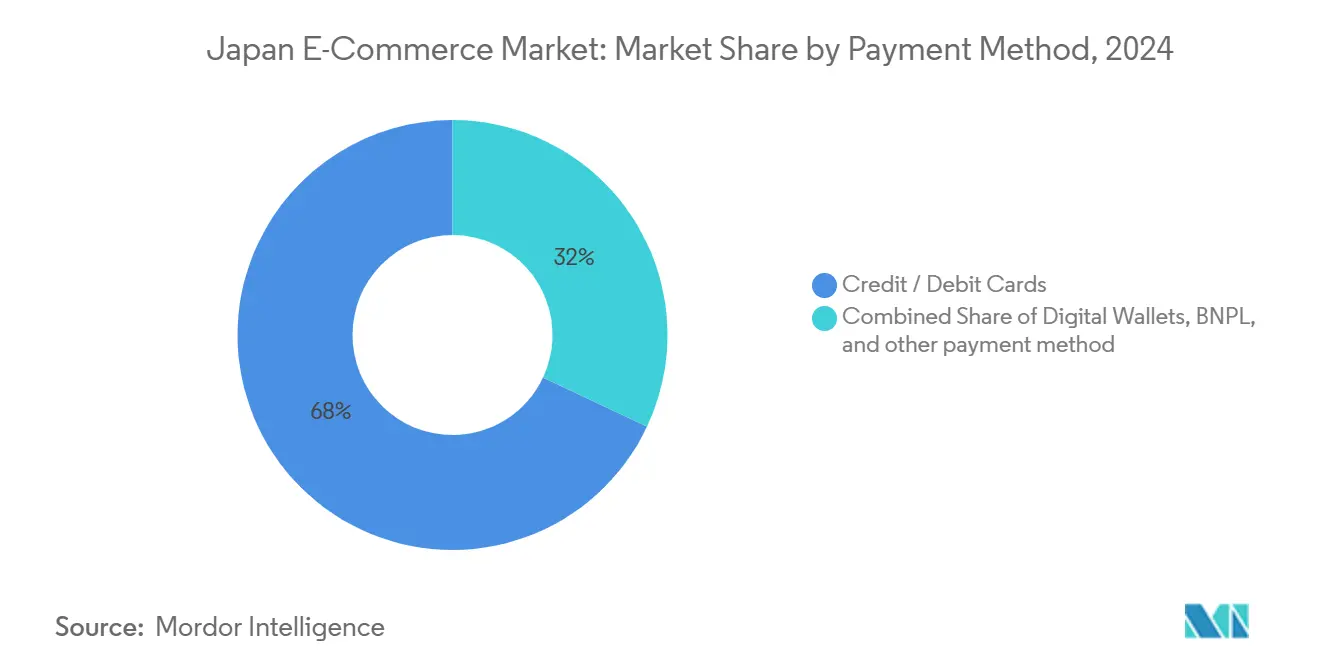
Note: Segment shares of all individual segments available upon report purchase
By B2C Product Category: Food Leads While Beauty Accelerates
Food & beverages booked a 20% share and JPY 2.93 trillion (USD 19.5 billion) in 2024 sales, energised by hour-slot urban delivery and meal-kit uptake. Organic produce specialists like Oisix capture premium margins, while national supermarket chains extend “dark-store” operations to match speed promises.
Beauty & personal care advances at a 12.8% CAGR, levelling up the Japan e-commerce market size for the segment as AR try-on mitigates product-fit uncertainty. Live tutorials during promotion weeks align entertainment with sales, driving basket-mix diversification. Consumer electronics, fashion, furniture, toys, and DIY continue to broaden assortment depth, each benefiting from visualisation tools and hobby-community engagement.
Geography Analysis
Japan’s e-commerce leadership within Asia-Pacific stems from sophisticated urban logistics and exacting consumer-protection norms that elevate average ticket values. Metro areas of Tokyo, Osaka, and Nagoya account for a majority share of online turnover and post double-digit mobile wallet adoption growth. Hyper-local fulfillment hubs compress lead-times, standardising 1-hour delivery as table stakes for fresh food and urgent pharmacy orders. Voice and AR features resonate with tech-savvy households, encouraging trial of emerging commerce formats.
In contrast, rural prefectures display lower but catching-up penetration as fibre rollouts and smartphone subsidisation narrow the connectivity gap. Cash-on-delivery loyalty and sparse courier coverage temper adoption; however, mobile-signal upgrades and drone-delivery pilots are beginning to unlock latent demand. Government grants for digital-literacy workshops also catalyse merchant onboarding on nationwide marketplaces, broadening supply choice.
Cross-border spending registered JPY 4.208 trillion (USD 28 billion) in 2024, with China and the United States as principal source markets. Yen weakness raises import costs yet bolsters Japan-origin exports, producing a mixed impact on platform GMV. Regional peers monitor Japan’s ecosystem approach—combining payments, points, and media—to inform their own digital-retail roadmaps. JETRO notes that stable growth potential and high transaction values position the Japan e-commerce market as an innovation reference point across Asia.
Competitive Landscape
Japan’s e-commerce playing field remains moderately concentrated, with the top five operators controlling roughly 70% of revenue. Rakuten leverages its loyalty-points flywheel, fintech offerings, and baseball franchise branding to strengthen customer lifetime value. Amazon Japan invests in robotics and regional sortation centres to uphold next-day standards beyond cities. Yahoo Japan ties search, media, and PayPay wallet to preserve relevance, while Mercari leads C2C through frictionless listing and AI counterfeit detection. ZOZO dominates fashion via size-mat-driven fit assurance and personalised styling feeds.
Technology deployment is the prime battleground. Leaders integrate AI-led recommendation engines and predictive inventory to compress returns and lift conversion. Autonomous-delivery trials in partnership with municipalities seek to relieve driver shortages and differentiate service levels. Ecosystem expansion into credit cards, telecom services, and streaming content aims to increase user lock-in. White-space opportunities remain in senior-targeted platforms, luxury re-commerce, and fragmented B2B verticals like building materials.
Regulatory compliance costs under the Digital-Platform Fair-Trading Act reshape competitive calculus, favouring players with robust legal resources. Aggressive price entrants from China, such as SHEIN and Temu, inject deflationary pressure but also accelerate category-expansion strategies by incumbents. Overall, innovation cadence and ecosystem completeness will decide share shifts within the Japan e-commerce market during the forecast horizon.
Japan E-commerce Industry Leaders
-
Rakuten Group, Inc.
-
Mercari, Inc.
-
Amazon Japan G.K.
-
Yahoo Japan Corporation
-
DMM.com LLC
- *Disclaimer: Major Players sorted in no particular order
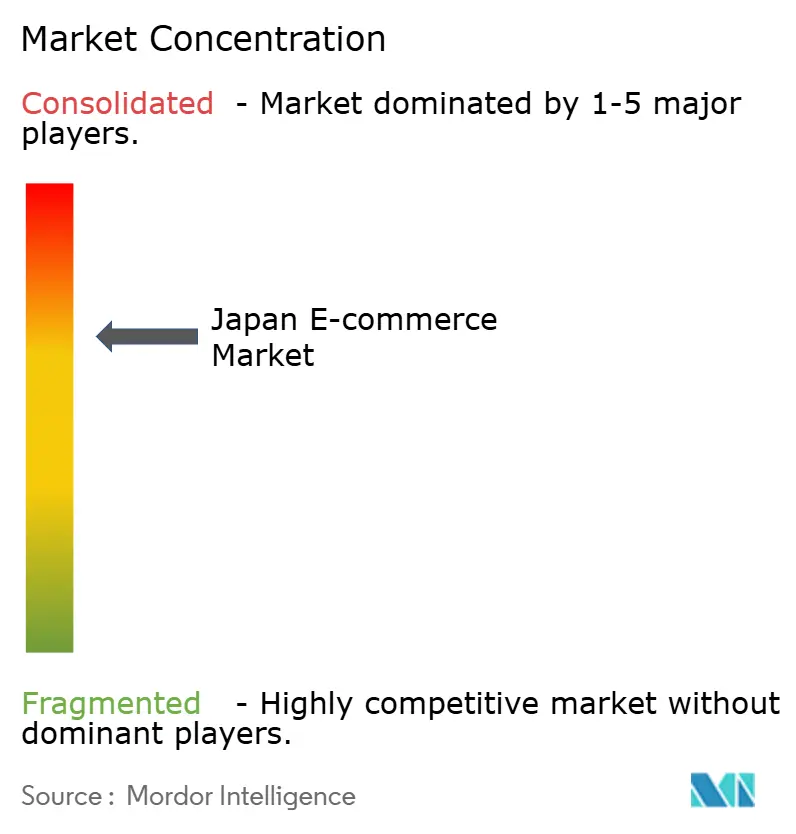
Recent Industry Developments
- March 2025: Rakuten Group extended autonomous delivery robots from groceries to its flagship marketplace, signalling a strategic pivot toward robotics to ease labour shortages while enhancing last-mile reliability.
- February 2025: Retail Asia projected the Japan e-commerce market to reach USD 206.8 billion in 2025, underscoring continued consumer migration to online channels, especially via mobile devices.
- January 2025: Yamato Transport and Japan Post formed a logistics alliance that reallocates parcel and letter volumes, aiming to optimise network utilisation and soften the impact of driver-hour legislation on nationwide delivery capacity.
- December 2024: The Japan Fair Trade Commission published guidelines under the Act on Promotion of Competition for Specified Smartphone Software to safeguard innovation, signalling stricter oversight of app-store fee structures and ranking algorithms.
Research Methodology Framework and Report Scope
Market Definitions and Key Coverage
Mordor Intelligence defines the Japan e-commerce market as every online transaction, B2C, B2B, and C2C, concluded via internet-enabled devices, expressed in gross merchandise value (USD). The valuation covers domestic and inbound cross-border orders for physical goods and fee-based digital services settled through cards, wallets, BNPL, bank transfer, or cash on delivery.
Scope Exclusion: in-app gaming spend, ticket-resale markups, and marketplace advertising revenue lie outside this study.
Segmentation Overview
- By Business Model
- B2C
- B2B
- C2C
- By Device Type
- Smartphone / Mobile
- Desktop and Laptop
- Other Device Types
- By Payment Method
- Credit / Debit Cards
- Digital Wallets
- BNPL
- Other Payment Method
- By B2C Product Category
- Beauty and Personal Care
- Consumer Electronics
- Fashion and Apparel
- Food and Beverages
- Furniture and Home
- Toys, DIY and Media
- Other Product Categories
Detailed Research Methodology and Data Validation
Primary Research
We spoke with marketplace managers, logistics integrators, and card-scheme executives in Kanto, Kansai, and Kyushu.
Their insights on basket values, mobile-checkout share, and fulfillment constraints calibrated several model assumptions.
Desk Research
Our team began with tier-1 public sources such as METI's FY-2023 EC survey, Statistics Bureau household outlay tables, Bank of Japan payment statistics, and UN Comtrade import flows to size cross-border demand. JADMA whitepapers plus peer-reviewed work on last-mile costs rounded out behavioral inputs.
We then tapped D&B Hoovers for merchant splits and Dow Jones Factiva for deal flow to validate retailer concentration, while company filings, investor decks, and respected news portals filled recent event gaps. The sources listed are illustrative; many additional open and paid references informed our desk analysis.
Market-Sizing & Forecasting
A top-down build started with METI yen totals for B2C, B2B, and C2C, converted to USD using annual average FX, and trimmed for items beyond scope. Select bottom-up checks, sampled platform GMV roll-ups and payment-provider volume disclosures, tested and fine-tuned the totals. Key drivers in our ARIMA with exogenous inputs forecast include smartphone penetration, disposable income per capita, card transaction volume, parcel capacity growth, and cross-border spending propensity. Scenario bands capture labor shortage or tax policy shocks.
Data Validation & Update Cycle
Two analysts review every figure; variances above ±5 % trigger fresh source audits.
We refresh the dataset each year and issue interim updates when FX swings, tax reforms, or major M&A materially alter the baseline.
Why Mordor's Japan E-Commerce Baseline Commands Reliability
Published estimates differ because providers vary segment mix, FX treatment, and refresh cadence. We flag those realities so clients can trace exactly what sits inside our totals.
Key Gap Drivers: some studies track retail B2C only, others fold gaming micro transactions into GMV, and several freeze exchange rates at report launch. Mordor revisits both macro and micro signals annually, which narrows drift.
Benchmark comparison
| Market Size | Anonymized source | Primary gap driver |
|---|---|---|
| USD 186.9 B (2025) | Mordor Intelligence | - |
| USD 206.8 B (2025) | Global Consultancy A | Excludes C2C, single-day FX snapshot |
| USD 258.0 B (2024) | Industry Association B | Includes digital content and gaming spend |
| USD 195 B (2024) | Regional Consultancy C | Partial B2B coverage, five-year-old FX base |
These comparisons show that our disciplined scope selection, iterative validation, and transparent variables yield a balanced, reproducible baseline for decision-makers.
Key Questions Answered in the Report
What is the current value of the Japan e-commerce market?
The Japan e-commerce market size is USD 186.93 billion in 2025 and is on track for double-digit growth to 2030.
Which business model generates the most online revenue in Japan?
B2B transactions dominate with an 88% share in 2024, reflecting the country’s manufacturing-centric economy.
How fast are digital wallets growing compared with cards?
Digital wallets are expanding at an 18.1% CAGR through 2030, outpacing card growth while still trailing cards’ 68% share in 2024.
What categories are driving B2C e-commerce expansion?
Food & beverages lead in revenue share, whereas beauty & personal care records the fastest 12.8% CAGR thanks to AR try-on and livestream sales.
How are logistics challenges being addressed after the “2024 Problem”?
Carriers are testing autonomous robots, cargo flights, and partnerships to offset driver shortages and sustain delivery speed commitments.
Why is the silver-economy important for future growth?
Urban seniors are allocating more of their JPY 230,000 monthly spend online, boosting average order values and underpinning steady demand in a maturing population.
Page last updated on:
